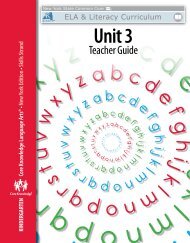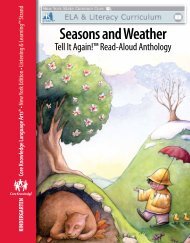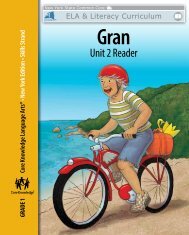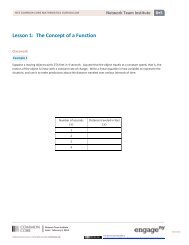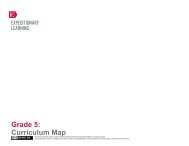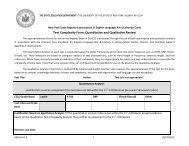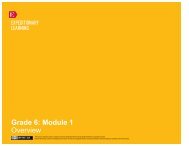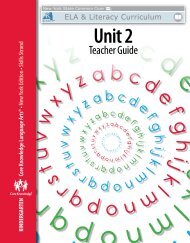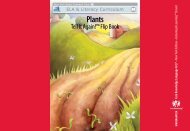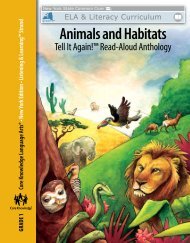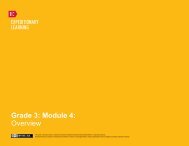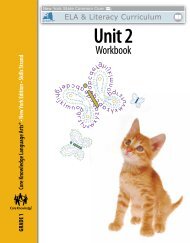Grade 3 ELA Module 1, Unit 2, Lesson 5 - EngageNY
Grade 3 ELA Module 1, Unit 2, Lesson 5 - EngageNY
Grade 3 ELA Module 1, Unit 2, Lesson 5 - EngageNY
Create successful ePaper yourself
Turn your PDF publications into a flip-book with our unique Google optimized e-Paper software.
<strong>Grade</strong> 3: <strong>Module</strong> 1: <strong>Unit</strong> 2: <strong>Lesson</strong> 5<br />
Independent Reading:<br />
Building the Power of Stamina<br />
This work is licensed under a Creative Commons Attribution-NonCommercial-ShareAlike 3.0 Unported License.<br />
Exempt third-party content is indicated by the footer: © (name of copyright holder). Used by permission and not subject to Creative Commons license.
GRADE 3: MODULE 1: UNIT 2: LESSON 5<br />
Independent Reading:<br />
Building the Power of Stamina<br />
Long-Term Targets Addressed (Based on NYSP12 <strong>ELA</strong> CCLS)<br />
I can identify the main message or lesson of a story using key details from the text. (R.L.3.2)<br />
I can make connections between texts and ideas to comprehend what I read. (R.L.3.11)<br />
I can choose a text that interests me. (RL.3.11)<br />
Supporting Learning Targets<br />
• I can identify the main message of The Incredible Book-Eating Boy.<br />
• I can make connections between my life, other books, or ideas to help me understand The<br />
Incredible Book-Eating Boy.<br />
• I can demonstrate stamina as I read a book that interests me.<br />
Ongoing Assessment<br />
• Teacher observation<br />
• Student notes<br />
• Reading Stamina tracker<br />
Agenda<br />
1. Opening<br />
A. Engaging the Reader (5 minutes)<br />
B. Read-aloud and Discussion: The Incredible Book-<br />
Eating Boy (15 minutes)<br />
2. Work Time<br />
A. Reading Stamina: Fishbowl and Discussion (10<br />
minutes)<br />
B. Student Practice: Building Reading Stamina and<br />
Completing the Stamina Tracker (20 minutes)<br />
Teaching Notes<br />
• Note that unlike other books in this module, The Incredible Book-Eating Boy is used just as a readaloud<br />
and as brief whole group discussion to get kids thinking about the idea of reading stamina.<br />
Students do not do a close reading of this text; instead, they spend time in class practicing reading<br />
stamina with their independent reading book.<br />
• This lesson reminds students of the importance of reading a high volume of books at their own reading<br />
level. This proves particularly helpful for building student reading fluency and the academic vocabulary<br />
that the CCLS demands. See the <strong>Unit</strong> 2 Recommended Texts lists for books at various Lexile ranges<br />
related to the topic of this unit.<br />
• Preread The Incredible Book-Eating Boy.<br />
• Prepare to model the behaviors of a proficient independent reader.<br />
Copyright © 2013 by Expeditionary Learning, New York, NY. All Rights Reserved. NYS Common Core <strong>ELA</strong> Curriculum • G3:M1:U2:L5 • June 2013 • 1
GRADE 3: MODULE 1: UNIT 2: LESSON 5<br />
Independent Reading:<br />
Building the Power of Stamina<br />
Agenda (continued)<br />
3. Closing and Assessment<br />
A. Debrief (5 minutes)<br />
B. Self-Assessment (5 minutes)<br />
4. Homework<br />
Teaching Notes<br />
• Be sure all students have a book to read on their own or provide time for students to select a book at<br />
their independent reading level.<br />
• Review Fishbowl protocol.<br />
• Adapt the model Reading Stamina tracker as necessary.<br />
• Some students may benefit from instruction or review of these terms: power, increase, fishbowl,<br />
whisper, spot, “stick with.”<br />
<strong>Lesson</strong> Vocabulary<br />
identify, predictions, connections,<br />
proficient, demonstrate, stamina,<br />
interests, share, self-assess, evaluate,<br />
atlas, fierce, fussy, digest, properly,<br />
accident<br />
Materials<br />
• The Incredible Book-Eating Boy (book; one text for the teacher)<br />
• Reading Stamina tracker (one per student and one to display)<br />
• Chart paper<br />
• Note cards<br />
• Document camera (or interactive white board)<br />
• Index cards<br />
• Chart paper for new anchor chart: Building Reader Stamina<br />
• Timer<br />
Copyright © 2013 by Expeditionary Learning, New York, NY. All Rights Reserved. NYS Common Core <strong>ELA</strong> Curriculum • G3:M1:U2:L5 • June 2013 • 2
GRADE 3: MODULE 1: UNIT 2: LESSON 5<br />
Independent Reading:<br />
Building the Power of Stamina<br />
Opening<br />
A. Engaging the Reader (5 minutes)<br />
• Begin by asking students to form groups of three or four. Invite each student to share out two or three of their favorite words<br />
they selected for homework and explain why they chose those words.<br />
• Remind the students of the story they read over the last two days, The Boy Who Loved Words. Ask the class: “What<br />
challenges did Selig face? How did Selig use words to help others? What superpowers did he develop as a reader?” Students<br />
should share that Selig felt lonely and overwhelmed by all the words he collected. He decided to spread his love of words<br />
with other people. Selig built his word power in this text.<br />
• Orient the students to today’s first target: “I can identify the main message of The Incredible Book-Eating Boy.”<br />
• Underline the words identify, the main message, and share: “We have done this many times this year. We did this with<br />
Thank You, Mr. Falker and The Boy Who Loved Words. The main message in Thank You, Mr. Falker is that Trisha had to<br />
work hard, practice, and build her own reading superpowers to become an independent reader.” Ask students to identify the<br />
main message of The Boy Who Loved Words. Give them a minute to Think-Pair-Share. Invite one or two students to share<br />
their ideas with the whole class.<br />
• Orient students to the second target and read it aloud: “I can make connections between my life, other books, or ideas to<br />
help me understand The Incredible Book-Eating Boy.” Ask: “How might making connections between our own lives, other<br />
books, or other ideas help us understand a new book?” Give students a moment to think about this, then ask them to share<br />
with someone nearby. Have a few students share their thoughts with the whole group. Clarify as needed, perhaps using a<br />
connection to Thank You, Mr. Falker as an example. This could sound like: “When I was reading Thank You, Mr. Falker, I<br />
thought about how hard it was for me to learn how to [insert example, here, such as dance]. I felt scared and embarrassed at<br />
first. I had to work really hard, practice a lot, and get some help from an expert. As I read what was happening to Trisha, I<br />
realized I knew what this was like and I could really ‘get’ what she was going through. This connection to my own life really<br />
helped me understand the book.” Model briefly as needed. When it is clear students understand the instructions, release<br />
them to independent work.<br />
Meeting Students’ Needs<br />
• Clarifying vocabulary meets the<br />
needs of ELLs and other students<br />
developing academic language.<br />
Copyright © 2013 by Expeditionary Learning, New York, NY. All Rights Reserved. NYS Common Core <strong>ELA</strong> Curriculum • G3:M1:U2:L5 • June 2013 • 3
GRADE 3: MODULE 1: UNIT 2: LESSON 5<br />
Independent Reading:<br />
Building the Power of Stamina<br />
Opening (continued)<br />
B. Read-aloud and Discussion: The Incredible Book-Eating Boy (15 minutes)<br />
Note: Unlike the other read-alouds in this module, the Incredible Book-Eating Boy read-aloud is interactive. This is because students<br />
will not do a close read of this text. Therefore, students need time to think and talk during the read-aloud. Be sure that<br />
throughout, students get to do the thinking and talking: Ask a question, let them ponder, and then address any confusion or<br />
misconceptions.<br />
• Display The Incredible Book-Eating Boy on the interactive white board or document camera.<br />
Meeting Students’ Needs<br />
• Increase interactions with<br />
vocabulary in context. This<br />
increases the rate of vocabulary<br />
acquisition for ELLs and other<br />
students.<br />
• Invite the students to look at the illustrations as you flip through each page of the book. Have students Think-Pair-Share<br />
about what the message of the story might be. Ask a few students to share their predictions.<br />
• Begin to read the text aloud to the students. Stop several times to ask questions and discuss what is happening in the story:<br />
* Page 4: Point out the image of Henry eating books. Ask students: “What do you see?” Invite them to turn and talk. Then<br />
ask about connections they make between what Henry is doing and their own lives. Listen for comments about eating. Ask<br />
students: “Can eating a book really make you smarter?”<br />
* Page 5: Linger on the word fierce. Ask students to try to figure out this word in context. Invite them to Think-Pair- Share.<br />
Guide students to understand that in this context, fierce means “incredibly rapid.”<br />
* Page 7: Ask: “When I read that Henry’s belly gets full when he eats books, I make a connection to how eating food makes<br />
me full. What gets full when we read books?” Invite students to Think-Pair-Share. Students may need help understanding<br />
that Henry does not actually eat books; it is a metaphor for him being a voracious reader.<br />
* Continue reading aloud, stopping periodically to emphasize key academic vocabulary or key phrases that will help<br />
students understand the main message. Be sure that throughout, students get to do the thinking and talking. Ask a<br />
question, let them ponder, and then address any confusion or misconceptions.<br />
* Stop on page 10. Then discuss with the class: “How does Henry become a true reader?” Give students time to Think-Pair-<br />
Share. They should share that instead of eating the books, Henry reads the books and discovers he can still become the<br />
smartest person on earth.<br />
• Invite the students to discuss what they learned about being a reader from The Incredible Book-Eating Boy. Ask: “What<br />
reading superpower did Henry develop that you could use when you read?” Students should share that Henry learned<br />
reading a lot can make him smarter and that reading takes time.<br />
Copyright © 2013 by Expeditionary Learning, New York, NY. All Rights Reserved. NYS Common Core <strong>ELA</strong> Curriculum • G3:M1:U2:L5 • June 2013 • 4
GRADE 3: MODULE 1: UNIT 2: LESSON 5<br />
Independent Reading:<br />
Building the Power of Stamina<br />
Work Time<br />
A. Reading Stamina: Fishbowl and Discussion (10 minutes)<br />
• Orient students to the final learning target: “I can demonstrate stamina as I read a book that interests me.” Invite the<br />
students to discuss what stamina is and how they demonstrate that as a reader.<br />
• Tell students they will observe the independent reading behaviors of a reader (or readers) inside the Fishbowl. The models<br />
may be adults, older students in the school, or students from the class who have practiced in preparation for the model.<br />
• Remind students that their job during a Fishbowl is to watch and listen closely. They will use a recording form to write down<br />
their observations. Ask: “What do you see these readers doing to build their stamina?”<br />
• After a few minutes, ask students to Pair-Share two things they saw these readers doing. Create an anchor chart of student<br />
ideas and add any additional ideas as necessary. This Building Reading Stamina anchor chart might contain ideas<br />
like:<br />
* How do we build our reading stamina?”<br />
* Stay in my reading spot<br />
* Read silently or in a whisper voice<br />
* Read the whole time<br />
* Stick with my book until I finish it<br />
* Use reading strategies to understand what I read<br />
* Read carefully, and don’t just eat books like Henry<br />
• Discuss these strategies so students understand them clearly. Add pictures to support comprehension.<br />
• Show students a Reading Stamina tracker. Tell them that they will self-assess, or evaluate, how they did building their<br />
stamina as readers.<br />
B. Student Practice: Building Reading Stamina and Completing the Stamina Tracker (20 minutes)<br />
• Be sure all students have a book to read. Tell them they will have 15 minutes for their first try at practicing stamina. The goal<br />
is to work up to at least 30 minutes of independent reading.<br />
Meeting Students’ Needs<br />
• Consider allowing students to draw<br />
their observations, ideas, or notes<br />
when appropriate. This allows ELLs<br />
to participate in a meaningful way.<br />
• Provide anchor charts for processes<br />
such as “How do we build our<br />
reading stamina?” This would<br />
include stamina words with<br />
nonlinguistic representations.<br />
• Providing text choice for students<br />
fosters engagement.<br />
• Set the timer; observe students as they read. Confer with readers as appropriate and give verbal time checks and praise to<br />
maintain engagement.<br />
Copyright © 2013 by Expeditionary Learning, New York, NY. All Rights Reserved. NYS Common Core <strong>ELA</strong> Curriculum • G3:M1:U2:L5 • June 2013 • 5
GRADE 3: MODULE 1: UNIT 2: LESSON 5<br />
Independent Reading:<br />
Building the Power of Stamina<br />
Closing and Assessment<br />
A. Debrief (5 minutes)<br />
• Place students in small groups of three or four. Ask them to go around their group, first sharing something that they did well<br />
to build their stamina using the frame from their tracker: “One thing I did to build my stamina was ___.” During the second<br />
group go-round, students share a next step using the frame: “Next time, I will work hard to ______.”<br />
• After students share their stamina self-assessment, invite them to discuss a final question within their small group: “How<br />
will building your stamina increase your reading power?”<br />
• Call on a few students to share their answers.<br />
Meeting Students’ Needs<br />
• When ELLs are asked to produce<br />
language, consider providing a<br />
sentence frame or starter, or a cloze<br />
sentence to assist with language<br />
production and the structure<br />
required.<br />
B. Self-Assessment: (5 minutes)<br />
• Ask students to complete their Reading Stamina tracker. Reinforce the idea of honest reflection and that it’s okay to only hit<br />
some of the stamina criteria on the first try.<br />
• Challenge students to continue to work on their stamina at home.<br />
• Collect students’ Reading Stamina trackers to help plan next steps: Which students need support with their reading<br />
stamina?<br />
Homework<br />
Meeting Students’ Needs<br />
• Read independently at home tonight. Practice building your stamina as a reader. Set a goal for yourself of how many<br />
minutes you will try to read. Complete the Reading Stamina tracker to show your progress toward the target.<br />
Copyright © 2013 by Expeditionary Learning, New York, NY. All Rights Reserved. NYS Common Core <strong>ELA</strong> Curriculum • G3:M1:U2:L5 • June 2013 • 6
<strong>Grade</strong> 3: <strong>Module</strong> 1: <strong>Unit</strong> 2: <strong>Lesson</strong> 5<br />
Supporting Materials<br />
This work is licensed under a Creative Commons Attribution-NonCommercial-ShareAlike 3.0 Unported License.<br />
Exempt third-party content is indicated by the footer: © (name of copyright holder). Used by permission and not subject to Creative Commons license.
GRADE 3: MODULE 1: UNIT 2: LESSON 5<br />
Reading Stamina Tracker<br />
Name:<br />
Date:<br />
Book Title:<br />
This Means I: Not These Yet. Still Working on It! I did it!<br />
Stay in my reading spot<br />
Read silently or in a whisper<br />
voice<br />
Read the whole time<br />
Stick with my book until I finish<br />
it<br />
Use reading strategies to<br />
understand what I read<br />
Read carefully, and don’t just<br />
eat books like Henry did<br />
One thing I did to build my stamina was:<br />
Next time, I will work hard to:<br />
Copyright © 2013 by Expeditionary Learning, New York, NY. All Rights<br />
Reserved. NYS Common Core <strong>ELA</strong> Curriculum • G3:M1:U2:L5 • June 2013 • 1



